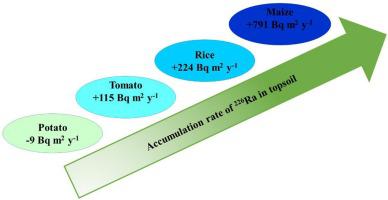当前位置:
X-MOL 学术
›
Agric. Water Manag.
›
论文详情
Our official English website, www.x-mol.net, welcomes your feedback! (Note: you will need to create a separate account there.)
Long-term accumulation of 226Ra in some agricultural soils based on model assessment
Agricultural Water Management ( IF 6.7 ) Pub Date : 2021-01-01 , DOI: 10.1016/j.agwat.2020.106453 Van Thang Nguyen , Nguyen Phong Thu Huynh , Ngoc Ba Vu , Cong Hao Le
Agricultural Water Management ( IF 6.7 ) Pub Date : 2021-01-01 , DOI: 10.1016/j.agwat.2020.106453 Van Thang Nguyen , Nguyen Phong Thu Huynh , Ngoc Ba Vu , Cong Hao Le

|
Abstract Groundwater and inorganic fertilizers are regularly applied to agricultural soils, but their 226Ra content is potentially hazardous to human health and the environment. Due to irrigation and fertilization processes, 226Ra can accumulate in topsoils, and might also leach to subsoils, groundwater, and surface water. However, there are few studies on the accumulation of radium in the agricultural soils due to irrigation with groundwater. In this work, we analysed the radium content in 60 groundwater samples collected from a coastal area of Phu Yen Province, Vietnam where groundwater is regularly used for irrigation practices. Long-term accumulation of 226Ra in agricultural topsoils due to irrigation with groundwater was modelled for rice, maize, potato, and tomato topsoils. The fate of 226Ra in the topsoil (0–20 cm) was studied by using the Canadian Environmental Modelling Centre (CEMC) soil model and the HYDRUS-1D model. We found that the total inputs of 226Ra were 0.83, 2.45, 0.24, and 0.57 Bq m−2 d−1 for rice, maize, potato, and tomato soils, respectively. The total removals were 0.145, 0.236, 0.272, and 0.125 Bq m−2 d-1 found in rice, maize, potato, and tomato soils, respectively. A simple formula was developed to calculate the accumulation rate of 226Ra in the topsoil. Using this model we predict that the activity concentration of 226Ra will increase in rice, maize, and tomato soil, but will remain almost unchanged in potato soils. The accumulation rates 226Ra were 224, 791, and 115 Bq m−2 y−1. After 25 years of agricultural practices, the total activity values of 226Ra that accumulate in rice, maize, and tomato soils can reach 5147, 17278, and 2711 Bq m−2, respectively. We found the good agreements in the results based on two models. The irrigation practices with groundwater samples contribute 96.7, 79.5, and 79.8 % of 226Ra to the accumulation rates of 226Ra in rice, maize, and tomato soils, respectively.
中文翻译:

基于模型评价的226Ra在部分农田土壤中的长期积累
摘要 地下水和无机肥料经常用于农业土壤,但其 226Ra 含量对人类健康和环境具有潜在危害。由于灌溉和施肥过程,226Ra 可以在表土中积累,也可能渗入底土、地下水和地表水。然而,关于地下水灌溉导致农业土壤中镭的积累的研究很少。在这项工作中,我们分析了从越南富安省沿海地区收集的 60 个地下水样本中的镭含量,该地区经常使用地下水进行灌溉。由于用地下水灌溉,农业表土中 226Ra 的长期积累被模拟为水稻、玉米、马铃薯和番茄表土。使用加拿大环境建模中心 (CEMC) 土壤模型和 HYDRUS-1D 模型研究了 226Ra 在表土(0-20 厘米)中的命运。我们发现,对于水稻、玉米、马铃薯和番茄土壤,226Ra 的总输入量分别为 0.83、2.45、0.24 和 0.57 Bq m-2 d-1。在水稻、玉米、马铃薯和番茄土壤中发现的总去除量分别为 0.145、0.236、0.272 和 0.125 Bq m-2 d-1。开发了一个简单的公式来计算表土中 226Ra 的积累率。使用该模型,我们预测 226Ra 的活性浓度将在水稻、玉米和番茄土壤中增加,但在马铃薯土壤中几乎保持不变。累积率 226Ra 分别为 224、791 和 115 Bq m-2 y-1。经过 25 年的农业实践,水稻、玉米、和番茄土壤可分别达到 5147、17278 和 2711 Bq m−2。我们在基于两个模型的结果中发现了良好的一致性。地下水样本的灌溉实践分别对水稻、玉米和番茄土壤中 226Ra 的积累率贡献了 226Ra 的 96.7%、79.5% 和 79.8%。
更新日期:2021-01-01
中文翻译:

基于模型评价的226Ra在部分农田土壤中的长期积累
摘要 地下水和无机肥料经常用于农业土壤,但其 226Ra 含量对人类健康和环境具有潜在危害。由于灌溉和施肥过程,226Ra 可以在表土中积累,也可能渗入底土、地下水和地表水。然而,关于地下水灌溉导致农业土壤中镭的积累的研究很少。在这项工作中,我们分析了从越南富安省沿海地区收集的 60 个地下水样本中的镭含量,该地区经常使用地下水进行灌溉。由于用地下水灌溉,农业表土中 226Ra 的长期积累被模拟为水稻、玉米、马铃薯和番茄表土。使用加拿大环境建模中心 (CEMC) 土壤模型和 HYDRUS-1D 模型研究了 226Ra 在表土(0-20 厘米)中的命运。我们发现,对于水稻、玉米、马铃薯和番茄土壤,226Ra 的总输入量分别为 0.83、2.45、0.24 和 0.57 Bq m-2 d-1。在水稻、玉米、马铃薯和番茄土壤中发现的总去除量分别为 0.145、0.236、0.272 和 0.125 Bq m-2 d-1。开发了一个简单的公式来计算表土中 226Ra 的积累率。使用该模型,我们预测 226Ra 的活性浓度将在水稻、玉米和番茄土壤中增加,但在马铃薯土壤中几乎保持不变。累积率 226Ra 分别为 224、791 和 115 Bq m-2 y-1。经过 25 年的农业实践,水稻、玉米、和番茄土壤可分别达到 5147、17278 和 2711 Bq m−2。我们在基于两个模型的结果中发现了良好的一致性。地下水样本的灌溉实践分别对水稻、玉米和番茄土壤中 226Ra 的积累率贡献了 226Ra 的 96.7%、79.5% 和 79.8%。


























 京公网安备 11010802027423号
京公网安备 11010802027423号